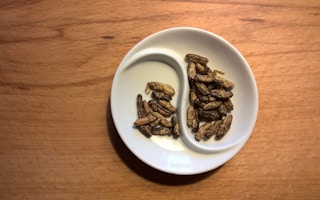The global market has a high demand for insect products, but Asian countries by far exhibit the greatest need for an affordable source of high-quality alternative nutrients. Currently, Asia accounts for 60 per cent of the global population, yet many Asian countries are forced to import a majority of their food, presenting a severe dependency problem.
Recent statistics show that over 345 million people worldwide are projected to be food insecure this year, with 900,000 struggling in famine-like conditions. Unfortunately, the cost of delivering food assistance is higher than ever because of price increases for both food and fuel. This poses problems not only with regards to global food insecurity but for countries that rely primarily on imported food, such as Singapore, which grows only 10 per cent of its food supply, and Japan, which can only farm on 11.3 per cent of its land.
Insect farming can help solve not just the issues of food insecurity and dependence on other economies; it also offers an opportunity for Asia to contribute to global gross domestic product (GDP) through the production of insect fertiliser and the export of insect-based products for humans and livestock.
Asia as an ideal insect farming hub
Reports say that the edible insect market for Asia Pacific will likely exceed $270 million by 2024 because of growing health concerns and a global shift toward protein-rich diets.
Here are four reasons why Asia is an ideal insect farming hub:
1. Climate and weather conditions
A stable climate throughout the year is one of the most important determining factors for successful insect farming. While it is true that an artificially stabilised environment can be created almost anywhere, it is far easier to do so when the outside temperature does not vary significantly.
For example, in Vietnam, the average temperature variation in a year is less than 10 degrees, whereas continental climates can experience much larger swings that range from -20 to +20 degrees. Relatively consistent temperatures make it easy to replicate ideal growing conditions for insect farms, which use only a fraction of the land and resources that traditional crop or livestock farming would need.
2. Favourable regulations
Many Asian countries are open to the possibilities of insect farming as a way to lower food import dependency and increase their overall GDP. For instance, the Singapore Food Agency (SFA) is poised to approve 16 species of insects, including crickets, silkworm cocoons and grasshoppers, for local food consumption. By the second half of 2023, these insects will be commonplace in dishes throughout the country.
Vietnam is another prime example of favorable regulations for insect farming. The Vietnamese government has established a legal framework that supports the farming of black soldier flies (BSF), a popular choice for these farms. BSF larvae are excellent for forming quality protein, oils and fertilisers, and they are able to be eaten by a wide range of animals. In addition, they can break down food waste much faster than many other organisms, meaning they can also contribute to increased levels of environmental sustainability.
3. Locally available raw materials
In addition to its plastic waste troubles, Southeast Asia also has a severe problem with food and organic waste. In fact, South and Southeast Asia together are responsible for 25 per cent of the entire planet’s food waste.
Countries like Cambodia, Indonesia, Myanmar, Thailand and Vietnam report that anywhere from 52 to 73 per cent of their total waste composition is from food or organic sources. As mentioned above, utilising BSF farms in these regions could help to significantly lower many Southeast Asian countries’ total waste output, reducing their environmental footprint.
The World Economic Forum refers to this as circular agriculture, diverting waste out of landfills, which are the second-highest producers of greenhouse gases, while adding value to the nation’s economy.
4. Insect-based fertilisers can tackle food crises
Agriculture is the primary contributor to the national economies of most Southeast Asian countries, and most are attempting to diversify their offerings. This means a skyrocketing demand for effective, affordable fertilisers, something that is currently a struggle to obtain because of a price spike in imported goods.
Locally produced insect-based fertilizers can help smooth much of this price volatility and help offset the overall demand from the agriculture sector. Companies like Protenga and Vietnam-based Kimmy Farm are already proving the benefits of local insect farming by providing black soldier fly products such as fertiliser and animal feed to farmers and ranchers in the region as well as elsewhere in the world.
Power of bugs
The global population is expected to surge to nearly 10 billion people by 2050, and the planet cannot currently sustain the levels of traditional agriculture needed to support that many people. Additionally, Asia alone is projected to grow to a population of 4.5 billion by 2030, despite its extremely low levels of arable land (that are continually declining) to feed such a population.
Traditional agriculture methods are land-, water- and resource-intensive that are in short supply for South and Southeast Asian countries. However, these regions are ideal candidates for the expansion of insect farming, which would not only help solve their massive organic waste problems but also provide a steady supply of locally available proteins, fertilizers and byproducts to support conventional agriculture and supplement it with the alternative nutrients found in insects.
Nathalie Berezina is chief technology officer of insect farming start-up FlyFeed.
To continue reading, subscribe to Eco‑Business.
There's something for everyone. We offer a range of subscription plans.
- Access our stories and receive our Insights Weekly newsletter with the free EB Member plan.
- Unlock unlimited access to our content and archive with EB Circle.
- Publish your content with EB Premium.


















